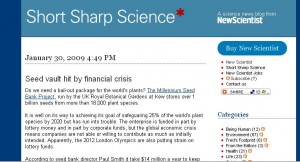The idea that maize and man co-opted one another in pursuit of world domination is not as new as some people seem to think. I’m reading “Corn and Capitalism: How a Botanical Bastard Grew to Global Dominance” by Arturo Warman, translated by Nancy Westrate. The original Spanish edition dates to 1988 and the translation to 2003, and although some bits have undoubtedly been updated the one over-riding impression I have so far is that all indicators of corn’s global dominance are probably now even greater than they are in the book. But that’s not why I am blogging.
Rather, I am puzzled by a reference on page 7 to a crop of American origin called sesame. That brought me up short. Sesame, Sesamum indicum, is almost certainly Indian in origin. Fortunately, Warman, or Westrate, gives a Latin name, Amaranthus cruentus, and says that it is known as Alegria, or “joy”. That makes more sense. A. cruentus is one of the three amaranth species grown for its grain, which admittedly does look a little like sesame seed. And it is the one often known in English as red amaranth, for the flower (and flour?) colour of a group of varieties that was, apparently, used as an element of ritual throughout the Americas. It represented blood, and that may have been the reason colonial religious nuts attempted to ban its cultivation and use. 1
Is there, then, some reason why Warman and Westrate refer to it as sesame? A Spanish word, perhaps?
All this is especially interesting in view of later paragraphs dedicated to the original domestication site of corn, Old World or New. 2 Part of the evidence that scholars adduced in support of an Old World origin was linguistic, names such as Egyptian sorghum, Syrian grain, grain from Mecca, Indian wheat, Spanish wheat, Portuguese grain and, here in Italy, Gran Turco. What all of these have in common is the notion that maize comes from somewhere else, often self-contradictory, but that was enough to send Old World supporters into a frenzy. They simply could not bring themselves to believe that such a wonderful plant had been domesticated by the lowly creatures of the Americas.
And speaking of names, it came as another shock to learn that Teosinte, the ancestor of maize, gets its name from a Nahuatl word for “corn of the gods”. How many other foods of the gods are there, I wonder?

